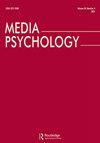Watching television in a home environment: effects on children’s attention, problem solving and comprehension
IF 2.6
2区 心理学
Q1 COMMUNICATION
引用次数: 2
Abstract
ABSTRACT Correlational studies have suggested some harmful effects of television viewing in early childhood, especially for the viewing of fast-paced entertainment programs. However, this has not been consistently supported by experimental studies, many of which have lacked ecological validity. The current study explores the effects of pace of program on the attention, problem solving and comprehension of 41 3- and 4-year-olds using an ecologically valid experimental design. Children were visited twice at home; on each visit they were shown an episode of a popular animated entertainment program which differed in pace: one faster paced, one slower paced. Children’s behavior was coded for attention and arousal during viewing, attention, and effort on a problem-solving task after viewing, and performance on unrelated (problem-solving) and related (program comprehension) tasks. The faster-paced program was attended to more, while 3-year-olds showed more attention and effort on the problem-solving task after watching the slower program, but there were no significant differences in performance on unrelated or related tasks depending on pace. The lack of differences observed in this naturalistic setting together with the high levels of comprehension of the programs watched provides some evidence to counter the “harm” perceived in young children watching fast-paced entertainment programs.在家庭环境中看电视:对儿童注意力、解决问题能力和理解力的影响
相关研究表明,儿童早期观看电视会产生一些有害影响,尤其是对观看快节奏娱乐节目的儿童。然而,这并没有得到实验研究的一致支持,其中许多研究缺乏生态学有效性。本研究采用生态有效的实验设计,探讨了程序节奏对41名3岁和4岁儿童注意力、问题解决和理解的影响。儿童在家中接受了两次探访;每次访问时,他们都会看到一个受欢迎的动画娱乐节目的一集,该节目的节奏各不相同:一个快节奏,一个慢节奏。儿童的行为被编码为观看过程中的注意力和唤醒,观看后解决问题任务的注意力和努力,以及在无关(解决问题)和相关(程序理解)任务中的表现。快节奏的节目受到了更多的关注,而3岁的孩子在观看慢节奏的节目后,对解决问题的任务表现出了更多的注意力和精力,但在不相关或相关任务上的表现没有显著差异,这取决于节奏。在这种自然主义环境中观察到的差异的缺乏,以及对所观看节目的高度理解,为对抗幼儿观看快节奏娱乐节目所感受到的“伤害”提供了一些证据。
本文章由计算机程序翻译,如有差异,请以英文原文为准。
求助全文
约1分钟内获得全文
求助全文
来源期刊

Media Psychology
Multiple-
CiteScore
8.60
自引率
7.10%
发文量
30
期刊介绍:
Media Psychology is an interdisciplinary journal devoted to publishing theoretically-oriented empirical research that is at the intersection of psychology and media communication. These topics include media uses, processes, and effects. Such research is already well represented in mainstream journals in psychology and communication, but its publication is dispersed across many sources. Therefore, scholars working on common issues and problems in various disciplines often cannot fully utilize the contributions of kindred spirits in cognate disciplines.
 求助内容:
求助内容: 应助结果提醒方式:
应助结果提醒方式:


